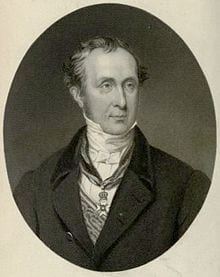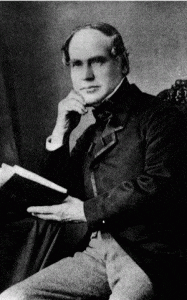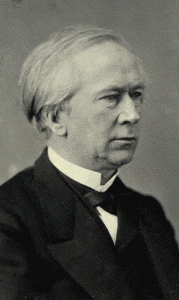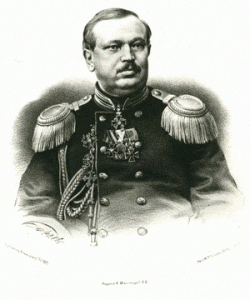Racing round Russia
On his first visit to Russia during the summer of 1840, Murchison extended his knowledge of European geology east from Germany and Poland, which he had visited earlier. In particular he was also able to revolve the ‘great Devonian controversy’ (Rudwick 1985) by finding specimens of marine Devonian fossils side-by-side with typical continental Old Red Sandstone fishes. On the basis of this first visit, Murchison planned a much more ambitious visit for 1841, for which he persuaded Tsar Nicholas I to commission him and provide imperial documents that would speed his progress.One of Murchison’s aims was to seek to understand the ‘lower New Red Sandstone’. Stratigraphers had used the terms ‘Old Red Sandstone’ and ‘New Red Sandstone’ to distinguish the two successions of red beds that lay respectively below and above the Carboniferous. The ‘upper New Red Sandstone’ had been named the Triassic by Alberti (1832), based on the tripartite German units (Bunter, Muschelkalk, Keuper), but this left unresolved the status of the ‘lower New Red Sandstone’.
 After visiting St Petersburg, Murchison, accompanied by Edouard de Verneuil, the French palaeontologist, Alexander von Keyserling, the Estonian Russian mining expert, and a young Russian army officer and mineralogist, Nikolai Koksharov, headed for Moscow. They investigated the Carbonifeorus limestones and sands south of Moscow in early May 1841, returned to Moscow to watch the Imperial military parades, and finally left the city of May 17th. The party of four geologists headed east from Moscow on the road to Nizhni Novgorod, and the party divided at the old monastery city of Vladimir, Verneuil and Keyserling taking a southerly route to Kazan, and Murchison and Koksharov continuing on the main road east.
After visiting St Petersburg, Murchison, accompanied by Edouard de Verneuil, the French palaeontologist, Alexander von Keyserling, the Estonian Russian mining expert, and a young Russian army officer and mineralogist, Nikolai Koksharov, headed for Moscow. They investigated the Carbonifeorus limestones and sands south of Moscow in early May 1841, returned to Moscow to watch the Imperial military parades, and finally left the city of May 17th. The party of four geologists headed east from Moscow on the road to Nizhni Novgorod, and the party divided at the old monastery city of Vladimir, Verneuil and Keyserling taking a southerly route to Kazan, and Murchison and Koksharov continuing on the main road east.
Murchison’s team
Sir Roderick Impey Murchison (1792-1871; see portrait left) was a Scot by birth, and he came from a moderately wealthy family that owned estates around Tarradale, in the north of Scotland. Murchison campaigned with Wellington in the Peninsular War, from 1808-1816. After leaving the army, he married Charlotte Hugonin, a devoted wife, who directed her somewhat errant husband away from an idle life of fox hunting into his lifelong career as a geologist, and travelled extensively with him, making watercolour sketches of scenes. Murchison had made his name by 1840 on the basis of 15 years of diligent field-based investigations of the geology of Britain and central Europe, and especially in establishing the Silurian and, with Adam Sedgwick, the Devonian systems.
Portraits (left to right) of Edouard de Verneuil (1805-1873), Alexander von Keyserling (1815-1891), and Nikolai Koksharov (1818-1893), all pictured rather later in their lives. The Verneuil and Koksharov portraits are from copyright-free online sources; the Koksharov portrait is from Münster (1865-9), courtesy of the Department of the History of Geology at the Vernadsky State Geological Museum in Moscow, with thanks to Irena Malakhova.
Edouard de Verneuil (1805-1873), the French palaeontologist (Daubrée 1875; Gaudant 2008; Santonja 2008) had learnt his palaeontology from Jean-Baptiste Elie de Beaumont, and he travelled widely over Europe and especially in the Crimea, in the 1830s. He made a special study of the fossils of the Devonian of the Bas-Boulonnais in France, and then travelled with Murchison and Sedgwick through the Rhenish provinces and Belgium in 1839. He was the obvious choice for Murchison who required a palaeontologist with wide experience of lower Palaeozoic fossils.
Alexander von Keyserling (1815-1891), the German-Russian mining expert (Rogers 1973) had been born in Kurland (part of Latvia), of a landed German family, hence his title ‘Graf’ (= Count), and was educated in Berlin before he took a position in the Russian civil service. He was a personal friend of Tsar Nicholas I, and is remembered for his work in geology as well as in botany and agriculture
Second lieutenant Nikolai Koksharov (1818-1893), the young Russian mineralogist (Münster 1865-9; Koksharov 1890; Shafranovsky 1964) had graduated from the Institute of the Corps of Mining Engineers in St Petersburg in 1840. The Institute had been placed under the command of the Ministry of Defence during military reforms of the Emperor Nicholas I, so all graduating students, as well as the teaching staff, held military ranks. Koksharov later became director of the Institute of Mines, and made significant contributions to mineralogy.
On the road to Vyazniki
Murchison describes the monastic and church splendours of Vladimir, and the road east to Vyazniki that he traversed with many side trips to look at the Carboniferous sands along the banks of the Klyaz’ma River (Collie and Diemer 2004, pp. 181-183). In his narrative account, intended to be published as a travelogue, but only finally published from a transcribed set of notebooks, Murchison (Collie and Diemer 2004, p. 184) wrote:
Viasniki is a pretty small town, with a very good (Russian) gastinitza or inn, the Nijny Gorodskaya. The town is at the base of red alluvial and diluvial hills, on a flat, from which the river has receded. Blocks of greenstone, quartz rock, etc., are tolerably abundant, and granite is scarce. The northern drift cover is very thin on the high ground between Viasniki and Goroghoretz [= Gorokhovets], and is often of a light grey whitish colour. But every here and there the red marl and sand, either regenerated, or in place, appears near the surface.
Further consideration of the red rocks is omitted, and Murchison wrote in the travelogue (composed and transcribed some time after his visit to Russia), ‘The geology of Vladimir and Viasniki I pass over, and refer to my big book’. This is presumably because he was unsure at the time of what he had found: the geologists had traversed huge amounts of undoubted Carboniferous sediments from Moscow to Vladimir, and somewhere between Vladimir and Vyazniki there had been a transition from Carboniferous to ‘red marl and sand’ – Murchison was then unsure whether these red beds represented the base of the new Red Sandstone or not. His views may be tracked through the series of publications that followed the expedition.
Murchison’s publications on the Permian
Murchison (1841) established the Permian System in a short paper, dated ‘Moscow Oct. 8, 1841’, sent to the journal from London on November 5th, and published in December. This was one of several summary documents and maps Murchison and his team prepared during October, in Moscow and St Petersburg, before they returned home. The Permian is founded primarily on the rocks he saw after visiting Vyazniki, east of the Volga: marine beds around Kazan, Perm itself, and Orenburg in the south: limestones with shells, gypsum, salt, and copper-bearing sandstones, lithologies that he had seen in the Zechstein of Germany and Magnesian Limestone of England. He argued that the marine molluscs were reminiscent of the Carboniferous and lant remains from the copper-bearing sandstones were Triassic in aspect. His new Permian then was the lower New Red Sandstone, plugging the gap between the well-known Carboniferous and Triassic of western Europe.Of the Vyazniki beds, Murchison (1841, p. 419) wrote ‘The overlying red deposits which occupy a great basin in the governments of Vologda and Nijni Novgorod, have not as yet been found to contain any organic remains except minute Cyprides and badly preserved Modiolae; but when we take into consideration their thickness, geological position, and mineral characters, we are disposed to think that they may at some future day be identified with a portion of the ‘Trias’ of German geologists.’ The Vyazniki red beds were then uppermost Permian or Lower Triassic, according to Murchison’s first impressions.
In their first substantial account, presented to the Geological Society of London in April 1842, Murchison and Verneuil (1842) provide further detail, giving lists of the marine fossils from the Kazan, Vyatka, Perm, and Orenburg regions, many regarded as intermediate in character between Carboniferous and Triassic forms, as well as the Zechstein flora and a first mention of reptile bones. This great basin of Permian rocks lay over Carboniferous seen to the west and east. In describing the overlying red sandstones and marls, Murchison and Verneuil (1842, p. 727) wrote: ‘At only Viasniki on the Kliasma could the authors detect any traces of fossils, and these are minute Cypridae, associated with apparently flattened Cyclades? which are imbedded in blood-red marl. The thick cover of detritus which is spread over a very large area, obscures the junction of these red deposits with the eastern edges of the carboniferous limestone of the Moscow and northern regions.’ As for the age of these deposits, Murchison and Verneuil leave the question open of whether they are uppermost Permian and Lower Triassic (Bunter). Nonetheless, they record ostracods (Cypridae) and large freshwater bivalves (Cyclades) from the Vyazniki red beds. Note that Collie and Diemer (2004, p. 183) mistakenly identify ‘Cyclades’ as ‘plant fragments’, but the term is used by Murchison as a plural version of Cyclas, a well-known genus of bivalve.
This, and numerous other short reports presented in 1842 and 1843, were a prelude to Murchison’s planned magnum opus, his Geology of Russia, published eventually in 1845 (Murchison et al. 1845), after a lengthy campaign to secure funding from Tsar Nicholas I, his patron. Here, the authors use words similar to those in their 1842 paper to describe the Vyazniki deposits, suggesting, as Collie and Diemer (2004, p. 183) note, that this part of the text was little changed since its first reading to the Geological Society in 1842. They described the discovery of the key fossils at Vyazniki (Murchison et al. 1845, p. 182):
At Vyasniki on the Kliasma and in the ravines to the east of the town, there is a clear section of marls, sometimes slightly micaceous and sandy, with other beds of light red and green colours, very finely laminated, overlaid by blood-red, incoherent sands passing into sandstones, yellowish sands and marls, and variegated, highly calcareous grit. In the light red, variegated marls towards the middle of the cliff, and in a ravine to the north of the high road, we detected a profusion of microscopic crustaceans resembling Cytherinae, associated with a small flattened bivalve shell, having the general form of Cyclas, and thee, as before said, are the only organic remains with the exception of a very small (fish?) bone observed near Nijni and now unfortunately lost, which we have been able to detect in these widely spread red strata of such very persistent lithological characters.
Then follows a brief review of the Permian east of the Volga, and the authors leave it open whether the red marls and sandstones of Vyazniki and Nizhni Novgorod are Permian or Triassic in age, but they conclude: ‘On the whole, however, we confess we are disposed to view these variegated sands and marls like those of Orenbourg as a part of the Permian system.’ However, in the definitive map (Murchison et al. 1845, pl. 6), the Vyazniki ‘Marls with Cytherinae’ are placed clearly at the top of the Permian, lying above the ‘Concretionary Limest.’ of Nizhni Novgorod, and these above a mixed succession of marls, limestones, sands, and other sediments from east of the Volga. The Vyazniki beds lie below Triassic gypsum, marls, and limestones of Mount Bogdo and other locations. Murchison and Verneuil (1845) strengthened their view that the Vyazniki beds were Permian, and not Triassic, because the fossils, they argued, were more like Carboniferous than Triassic assemblages. The text in Murchison et al. (1845) concerning Vyazniki was likely printed in 1842 or 1843 (Thackray 1978) and, although Murchison managed to insert revised sheets here and there, there were inevitable mismatches between text and map.The story of Murchison and his team, and their first observation of the Permian redbeds at Vyazniki, is told in more detail by Benton et al. (2010).
References
- Benton, M.J. 2015. When life nearly died: the greatest mass extinction of all time, 2nd edition. Thames & Hudson, London.
- Benton, M.J., Sennikov, A.G., and Newell, A.J. 2010. Murchison’s first sighting of the Permian, at Vyazniki in 1841. Proceedings of the Geologists’ Association 121, 313-318. pdf.
- Collie, M. and Diemer, J. 2004. Murchison’s wanderings in Russia. British Geological Survey, Nottingham, 474 pp.
- Daubrée, M. 1875. Notice nécrologique sur Edouard de Verneuil. Annales des Mines, 7ème Série 4, 318-320.
- Gaudant, J. 2008. Géologues et Paléontologues: de la Passion à la Profession. Éditions Presses de l’École des Mines, Paris, pp. 105-134.
- Koksharov N.I. 1890. Vospominaniya (‘Reminiscences’). Russkaya Starina 1890 (April-June), 1-20 (in Russian).
- Münster, A. 1865-1869. Portretnaya Gallereya Russkikh Deyateley. Tom 2. [Portrait Gallery of Russian Figures. 2 vols.] A. Münster Publishing House, St Petersburg.
- Murchison, R.I. 1841. First sketch of some of the principal results of a second geological survey of Russia, in a letter to M. Fischer. Philosophical Magazine and Journal of Science Series 3, 19, 417-422.
- Murchison, R.I. and Verneuil, E. de 1842. A second geological survey of Russia in Europe. Proceedings of the Geological Society of London 3, 717-730.
- Murchison, R.I. and Verneuil, E. de 1845. On the Permian System as developed in Russia and other Parts of Europe. Quarterly Journal of the Geological Society of London 1, 81-87.
- Murchison, R.I., Verneuil, E. de, and Keyserling, A. von 1845. The geology of Russia in Europe and the Ural Mountains. 2 vols. Volume 1, John Murray, London. Volume 2, Bertrand, Paris.
- Rogers, J.A. 1973. The reception of Darwin’s Origin of Species by Russian scientists. Isis 64, 484-503.
- Rudwick, M.J.S. 1985. The great Devonian controversy: the shaping of scientific knowledge among gentlemanly specialists. Chicago University Press, Chicago.
- Santonja, J. T. 2008. La influencia de Edouard de Verneuil en el desarrollo de la investigación de la geolog’a española de su época. Trabajos de Geología 28, 15-24.
- Shafranovsky I.I. 1964. Nikolai Ivanovich Koksharov. Nauka, Moscow-Leningrad, 216 pp.
- Thackray, J.C., 1978. R. I. Murchison’s Geology of Russia (1845). Journal of the Society for the Bibliography of Natural History 8, 421-433.




